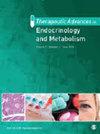HbA1c overestimates the glucose management indicator: a pilot study in patients with diabetes, chronic kidney disease not on dialysis, and anemia using isCGM
IF 4.6
3区 医学
Q2 ENDOCRINOLOGY & METABOLISM
Therapeutic Advances in Endocrinology and Metabolism
Pub Date : 2024-05-31
DOI:10.1177/20420188241252546
引用次数: 0
Abstract
Introduction:There are multiple mechanisms by which HbA1c values can be altered in chronic kidney disease (CKD), which limits its usefulness as a strategy to assess glycemic control in this population.Methods:Concordance and agreement study between two diagnostic tests: HbA1c and glucose management indicator (GMI) measured by intermittently scanned continuous glucose monitoring (isCGM), based in a prospective cohort of patients with diabetes, CKD (glomerular filtration rate between 15 and 60 ml/min/1.73 m²), and anemia. The isCGM was performed for 3 months, and the GMI was compared with the HbA1c levels taken at the end of isCGM. Agreement was evaluated using Bland–Altman graph analysis and Lin’s concordance correlation coefficient (CCC). The concordance of the measures with good glycemic control (<7%) was also evaluated.Results:A total of 74 patients were enrolled (median age 68.5 years, 51.3% female, 64.9% with CKD stage 3, hemoglobin 11.1 ± 1.2 g/l). The Bland–Altman analysis shows a mean difference between GMI and HbA1c of 0.757 ± 0.687% (95% limits of agreement: −0.590 and 2.105). Difference was greater as the values of GMI and HbA1c increased. The agreement was poor [CCC 0.477; 95% confidence interval (CI): 0.360–0.594], as well as the concordance of values with good glycemic control according to GMI versus HbA1c (67.5% versus 29.7%, p < 0.001) (Kappa 0.2430; 95% CI: 0.16–0.32).Conclusion:The HbA1c overestimates the GMI values with highly variable ranges of difference, which prevents a precise correction factor. isCGM probably is a safer option for monitoring and decision-making in this population, especially in patients treated with insulin where the risk of hypoglycemia is greater.HbA1c 高估了血糖管理指标:使用 isCGM 对糖尿病、非透析慢性肾病和贫血患者进行的试点研究
导言:慢性肾脏病(CKD)患者的 HbA1c 值会因多种机制发生改变,这限制了其作为评估该人群血糖控制情况的策略的实用性:方法:以糖尿病、慢性肾脏病(肾小球滤过率介于 15 至 60 毫升/分钟/1.73 平方米之间)和贫血患者的前瞻性队列为基础,对两种诊断测试:HbA1c 和间歇扫描连续葡萄糖监测(isCGM)测量的葡萄糖管理指标(GMI)进行一致性研究。isCGM为期3个月,将GMI与isCGM结束时的HbA1c水平进行比较。采用 Bland-Altman 图表分析和林氏一致性相关系数 (CCC) 对两者的一致性进行了评估。结果:共有 74 名患者入选(中位年龄 68.5 岁,51.3% 为女性,64.9% 为 CKD 3 期,血红蛋白 11.1 ± 1.2 g/l)。Bland-Altman 分析表明,GMI 与 HbA1c 之间的平均差异为 0.757 ± 0.687%(95% 一致度:-0.590 和 2.105)。GMI 和 HbA1c 值越高,差异越大。一致性较差[CCC 0.477;95% 置信区间 (CI):0.360-0.594],根据 GMI 与 HbA1c(67.5% 对 29.7%,p < 0.001),血糖控制良好值的一致性也较差(Kappa 0.2430;95% CI:0.16-0.32)。结论:HbA1c 过高估计了 GMI 值,其差异范围变化很大,因此无法获得精确的校正系数。在这一人群中,isCGM 可能是更安全的监测和决策选择,尤其是在使用胰岛素治疗的患者中,低血糖风险更大。
本文章由计算机程序翻译,如有差异,请以英文原文为准。
求助全文
约1分钟内获得全文
求助全文
来源期刊

Therapeutic Advances in Endocrinology and Metabolism
Medicine-Endocrinology, Diabetes and Metabolism
CiteScore
7.70
自引率
2.60%
发文量
42
审稿时长
8 weeks
期刊介绍:
Therapeutic Advances in Endocrinology and Metabolism delivers the highest quality peer-reviewed articles, reviews, and scholarly comment on pioneering efforts and innovative studies across all areas of endocrinology and metabolism.
 求助内容:
求助内容: 应助结果提醒方式:
应助结果提醒方式:


